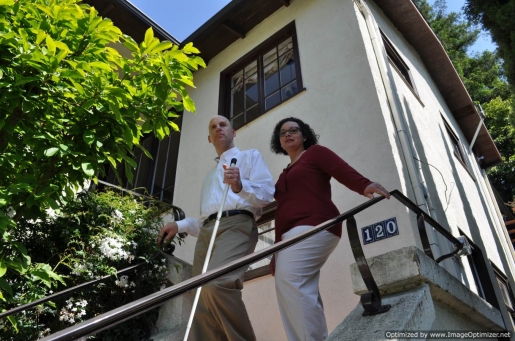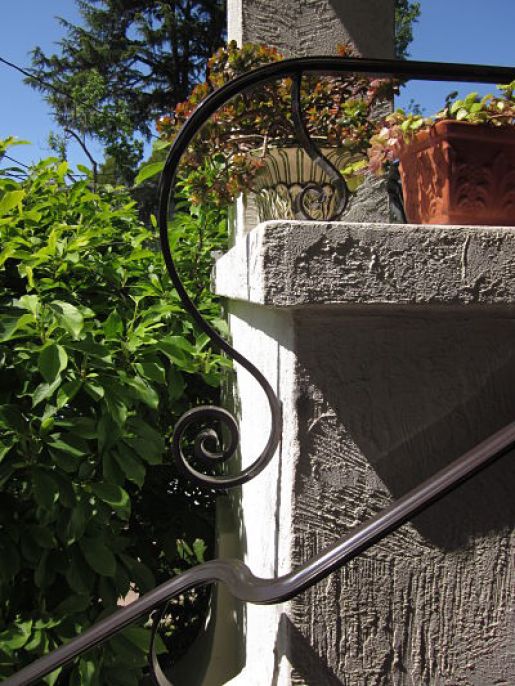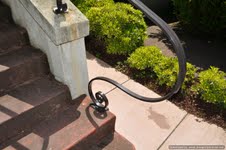You might also be interested in...
-
A course in good design
11/11/2011
-
Architect is visionary for the blind
05/16/2011
-
As you winterize your home, “futurize” it, too!
01/14/2014
-
Designed for All: Universal Design Living Laboratory, the National Demonstration Home & Garden
05/06/2013
-
Designing a university for all
03/07/2012
-
Easy living on the farm
10/28/2012
-
Existing homes can be friendlier to aging
10/08/2013
-
He made his home age-friendly
08/06/2013
-
Improving on good design to Age in Place
10/23/2013
-
Livable Communities
10/22/2013
Architect is visionary for the blind
Posted: 05/16/2011
By: Jan Goben

As a child, Chris Downey lived with his family in a home designed by an architect who ensured the house focused on a relationship with the landscape. Downey's senses were attuned to his surroundings: The sounds of birds outside, the feeling of the wind were issues he brought with him when he began his career as an architect.
Now he is even more attuned to the aesthetics of his surroundings. In 2008, surgery to remove a benign brain tumor left him blind, and, more than ever, reliant on his other senses.
"I've always enjoyed outdoor spaces," says Downey, 48, seen above with his wife, Rosa. "Now, more than ever. You hear the birds in the distance, the rustling in the trees. I'd like to have a home that's more alive."
Downey had sold his share in the firm Ashdown Downey to his partner and begun work at Michelle Kaufmann Designs when the surgery took his sight. He continued at MKD until December 2008 when the market for new housing tanked, and since then has created his own consulting business, Chris Downey Architect, where he focuses on helping clients and design teams alike to understand the needs of the blind as well as the sighted. Among his first clients were SmithGroup and The Design Partnership, the architectural firms designing the Polytrauma and Blind Rehabilitation Center for Veterans in Palo Alto (slated to begin construction this year) that will treat military personnel who have lost their vision in the wars in Iraq and Afghanistan.
Currently, he does consulting work for schools and rehabilitation centers for the blind, and transit centers.
While he believes there are elements of great architecture that are the same for the blind and the sighted alike, there are certain things he finds especially important in building for the blind.
"The legally blind cannot drive, so they need public transit," Downey says -- and public transit usually needs some improvements for the blind. There are certain things, such as braille on doors, braille on elevators, etc., that are especially helpful but are still lacking in many organizations, he says.
Architecture for the blind is starting to use "acoustics, touch, the things that help you recognize things, recognize where you are," Downey says.
"Can you design acoustics so you can tell where you are?" he asks, introducing some of the issues on which he is currently working.
For one project, other architects set a variety of tiles on the floor and asked him to tap them with his cane and tell which he preferred. "I tapped them all with my cane and I told them 'they all sound the same'," Downey says, explaining that he told the sighted architects the tiles were of no use to the blind because he couldn't tell the difference between them. (Tiles with directional patterns would be another matter, he said, because the direction of the pattern could lead a blind person in the right direction.)
Downey laments that technology in home design depends a great deal on eyesight: "Microwave ovens use push buttons," he says. "The thermostat goes up or down, but if you're blind, you can't tell by how much. Refrigerators use touch screens (with visual responses)."
On the other hand, Downey says computers are often helpful, because there are programs that use human voices to read messages aloud. There are also screen magnifiers to help those with limited vision. At work, he now uses an embossing printer, which prints out architectural drawings by pushing dots through the paper to create raised lines. He can feel the drawing with his fingers and understand the different areas.
"It feels as if I'm moving through the building as I'm using my fingertips," Downey says.
 He uses Wikki Stix -- a children's toy made of yarn covered with wax that can be manipulated into various shapes and will stick to paper -- to change a design or to show others how he would complete a building. Similarly, when it came to designing the railing that guides him up the stairs of his house (at right), he and Rosa, who is also an architect, stretched out the garden hose, curving it to form a configuration that was comfortable for Downey to hold and beautiful for everyone to see.
He uses Wikki Stix -- a children's toy made of yarn covered with wax that can be manipulated into various shapes and will stick to paper -- to change a design or to show others how he would complete a building. Similarly, when it came to designing the railing that guides him up the stairs of his house (at right), he and Rosa, who is also an architect, stretched out the garden hose, curving it to form a configuration that was comfortable for Downey to hold and beautiful for everyone to see.
Ninety-two percent of blind people have some sight, Downey says, whether it is simply to discern shapes and colors, or more, on a limited basis. Only 6 to 8 percent of the blind are completely blind, as Downey is, with no sight, no glimpses of color, light, or anything else.
"When I came home from the hospital, I was blind," he says. "Suddenly, the lights were turned out."
Because one-third of an individual's balance is based on eyesight, Downey says that handrails and grab bars are more important than people without vision problems may realize. Yet, in many buildings, the handrail alongside stairs stops before the final few steps, he says, explaining that many of these things are issues of which he had to suddenly become aware.
 The curving staircase that leads to his own house was a case in point: The original railing ended two steps shy of the landing. The new metal railing, designed with the help of landscape architect Chris Ford, and fabricated by Teppa Ironworks, now curves gracefully from porch to sidewalk, overhanging the beginning and ending of the steps.
The curving staircase that leads to his own house was a case in point: The original railing ended two steps shy of the landing. The new metal railing, designed with the help of landscape architect Chris Ford, and fabricated by Teppa Ironworks, now curves gracefully from porch to sidewalk, overhanging the beginning and ending of the steps.
Downey was born in Nashville, Tenn., where he lived until he was 13 and his family moved to Raleigh, North Carolina. He went to school at North Carolina State University to get a bachelor degree in environmental design in architecture, and he received his masters of architecture degree from the University of California at Berkeley. He and Rosa live in Berkeley with their teenage son.
Life has changed not only for Downey, but Rosa and their son have had to learn how to adapt to his blindness, making sure to keep pathways clear, for instance. Rosa tells visitors that she has had to become more aware of the challenges her husband faces, noting that being somewhat shorter than her six-foot-plus husband she has sometimes failed to notice an obstacle such as a protruding cornice that caught Downey sharply in the forehead as he walked up the aisle at the couple's church.
The Downeys have made the necessary changes to their home, installing grab bars and handrails, as well as hanging wind chimes on the front porch to help guide Downey as he walks home from the bus stop. He chuckles as he tells of being guided by the tapping sound made by a woodpecker lunching on a tree across the street from his house. The woodpecker had become a trusty guide over several weeks, until, one day, it moved to a tree several houses away, nearly leading him astray. The wind chimes may be more trustworthy than a woodpecker, but Downey says he still would like to be more aware of the outdoors in his home.
"I've always enjoyed outdoor spaces, now more than ever," he says. "I'd like to have a house that's more alive."
The 1990 Americans with Disabilities Act has mostly addressed mobility issues. Now there is talk of increasing the act to address the problems faced by people of low and no vision -- an area in which Downey is both interested, and gaining in expertise. When it comes to changes in the ADA, he notes he will be able to understand things that others might not, and that he will be able to help more than ever. "I still have insights that bring real value to my work. What otherwise would be read as a disability is a real strength now."
For the rehabilitation center for blind veterans, Downey helped to design an outdoor patio where people could go to take a break from their work and activities.
A courtyard was identified on the second floor "as a restorative place to go," Downey says. There, a fountain provides privacy through acoustical separation, and benches in a seating alcove have rougher texture than that of indoor seating to indicate to the blind that they are sitting in a patio space.
"So much goes into a building that you look at," Downey says, but it is these other issues that are important to the blind -- acoustics, the touch of the benches, the sound of the fountain, for example.
"I still have the insights that have brought real value to my work," he concludes.
Useful Resources:
- Chris Downey's website
- TED Talk given by Chris Downey
- Americans with Disabilities Act, updated
- Rebecca Firestone interviews Downey
- Hear Dr. Josh Miele discuss tech tools for blind